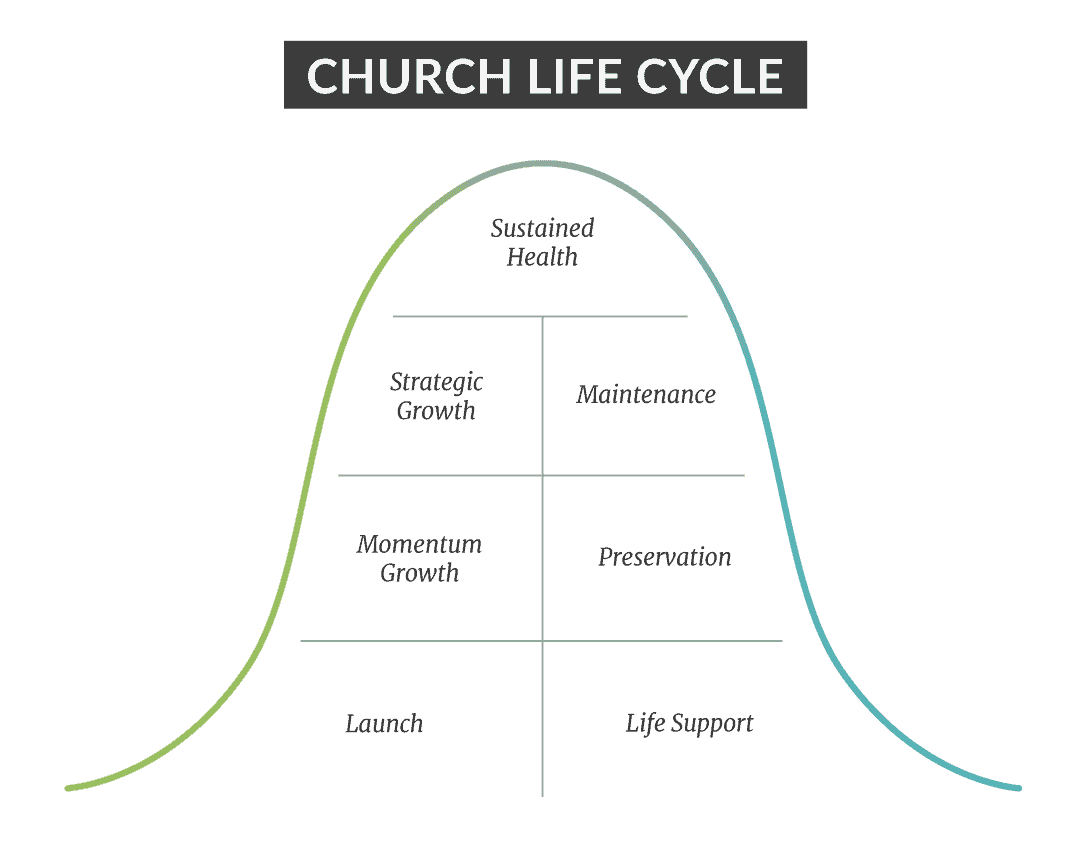Ask This, Not That (Part 1)
If you enjoy this episode, subscribe on your device for more:
iTunes RSS Stitcher Spotify
Most organizations start, grow, thrive, lose momentum, decline… and eventually end. The same is true for most churches.
We’re kicking off a new podcast series called, “Ask This, Not That,” exploring the seven phases of the church lifecycle: launch, momentum growth, strategic growth, sustained health, maintenance, preservation, and life support. If this lifecycle sounds familiar to you, it might be because I wrote a whole book around it a few years back called The Unstuck Church. The lifecycle looks like this:

ASK THIS, NOT THAT
In Part 1 of this series, Amy and I are walking you through the first three phases of the lifecycle, what we call “the growing side”: launch, momentum growth, and strategic growth. These are exciting phases to experience as a church leader, but we have to acknowledge that they can’t last forever. We have to be intentional in our strategy and leadership to move our church up the cycle and toward sustained health.
There are a few questions most leaders are asking in each phase, and then the questions they should be asking. We’ll discuss both, and also talk through:
- The characteristics of the launch, momentum growth, and strategic growth phases
- Developing systems vs. creating programs
- Why you should add a service, not a location
- The 3 S’s you need to experience strategic growth
Leader Conversation Guide
Want to take this conversation back to a staff or senior leadership team meeting?
Our Show Notes subscribers get a PDF download that recaps the episode content and includes a discussion guide you can print out and use at an upcoming meeting.
Opt-in here and get the Leader Conversation Guide for this episode, as well as access to the archive.
Connect on Social Media
We use #unstuckchurch on Twitter, and we start a real-time conversation each Wednesday morning when the episode drops. We love to hear your questions and reactions to the topic.
You can follow me @tonymorganlive and The Unstuck Group @unstuckgroup. If Facebook is where you spend your time, I’m there, too.
Links & Resources from the Episode
- Listen to Part 2 and Part 3 of the Ask This, Not That series
- A Comprehensive Guide to the Church Lifecycle
- The Unstuck Church Book
- Unstuck Church Assessment
Write a Review—It Helps!
Particularly on iTunes, your ratings and reviews really do help more pastors discover the podcast content I’m creating here. Would you take a minute to share your thoughts? Just open the the podcast on iTunes on your phone or computer, click Ratings & Reviews, and leave your opinion.
Transcript
Sean (00:02):
Welcome to The Unstuck Church Podcast, where each week we’re exploring what it means to be an unstuck church. No matter what size, denomination, network or number of campuses, every church has the potential to go through a very similar life cycle. They grow, thrive, decline and sometimes even end, and no matter what phase of life your church is currently in, the potential exists for you to get stuck. On this week’s podcast, Tony and Amy, begin a three-part series on the life cycle that’s common to churches with some key next steps, no matter what phase your church is in. If you haven’t yet, be sure to subscribe to get the podcast show notes. Each week, you’re going to get resources to go along with that week’s conversation, our leader conversation guide and access to our podcast resource archive. You can sign up by going to theunstuckgroup.com/podcast. Now let’s join Tony and Amy for today’s conversation.
Amy (00:58):
Well, today we’re kicking off a new podcast series focusing on the life cycle of a church. And this, of course, Tony is near and dear to you because you wrote a book about it a few years ago called The Unstuck Church. And it has helped thousands of church leaders over those few years get an objective view really where their church is at in their life cycle. And of course determine what their next steps need to be in order to either stay healthy or get healthier and be a more effective church. So in this series, we’re going to be highlighting the questions church leaders normally ask at each stage in the life cycle and the questions that they should be asking. And today we’re going to speak to those churches that are on the growing side of the life cycle. Before we dive in, though, Tony, can you just introduce and give a brief description of the three phases that make up the left side or the growing side of the life cycle?
Tony (01:48):
Absolutely. So they are these three phases: launch, momentum growth and strategic growth, and all of them are building towards sustained health, which is the pinnacle of the church life cycle. We’ll actually dedicate a full episode to that phase of the life cycle next week. But beginning with launch, you can think of this as the starting line. These are really the church plants or churches that are kind of replanting themselves with a fresh start and a fresh purpose. I love the season because this is when leaders have the opportunity to dream big, and they often do, about the future impact of the ministry. And in this phase, there’s a lot of focus on reaching new people with the gospel. I think the primary reason why though, there’s a lot of focus is they don’t have a lot of resources, there’s not a lot of people, and so they have to focus during the launch season. The second phase, momentum growth. And, Amy, I know you’ve been a part of a church that experienced this. I have as well. It is a fun season of ministry. The church is experiencing a lot of momentum. There’s a lot buzz. The inviting culture is so strong in this season for a church, people inviting their friends and family to come join them for a service or to connect with an event at the church. The team is unified and usually there’s a lot of creativity in this phase because traditions haven’t had time to get established. And so there’s more freedom to think about things in a new way. And the focus here? It’s all about making room for all the new people that are showing up. Physical space, actually for gatherings on Sunday services, but also just making room in the ministry life of the church as well. The third phase is about strategic growth and by the way, strategic that that’s a key word. And oftentimes when I’m talking about this phase of the church life cycle, it’s the word intentionality. We have to do things intentionally different than we have in the past. And with the growth that was and is happening in the church, there’s a recognition that the team needs systems, they need strategies, they need structure, all three of those S words, just start to become very, very necessary in this season. And so there’s a desire to bring some strategy to the ministry that’s having momentum and having success so that we can continue to see that growth and momentum moving forward. So Amy, that’s a quick overview of the first three phases of the church life cycle.
Amy (04:30):
Yeah, and as you were talking, and I should mention to our listeners, we’ll put a visual of the church life cycle in the show notes, if you haven’t seen it before, so you can track along that way. But Tony, as you were talking, and just thinking back on my ministry experience, I remember all three of those phases. I wasn’t there when our church launched. Well actually the church launched in 1949. So I literally wasn’t there. But this was a relaunch. Our church was kind of a relaunch of sorts that you mentioned because the church got stuck on that declining side of the life cycle for many, many years. Maybe got down to 250 people, but there was this core that just kept praying, you know, we want to use this building, our resources, to reach the community. So the church actually did relaunch. I don’t know if they would have said it that way at the time, but they brought in a new leader with a new, clear vision of what he wanted the church to do. And it started to grow. And eight years into that relaunch is when my husband and I started attending that church. And we were well into the momentum phase. Honestly, it was, we showed up and we could hardly find a seat. I mean, they were clearly right in the middle. They didn’t know what to do with all these people. There were people upstairs, downstairs, in the gym. But then we were heading into strategic growth because you just can’t deal with all that craziness. So kind of fun to think about that as you were walking us through those phases.
Tony (05:51):
Yeah, and momentum will only sustain a ministry for so long. And if you don’t start to get some of that strategy, the systems, the strategies, the structure in place, and we want that to continue for years for decades. And that’s why you just, it is a key pivot point for growing churches. How do we move from the momentum we’re experiencing to that strategic growth?
Amy (06:15):
Well, Tony we’ve said all along that churches can actually get stuck at any point in the life cycle, and not all growing churches reached that pinnacle you referenced of sustained health before they begin to decline. Some jump over to the right side fairly quickly if they don’t make the adjustments that you’re going to be talking through today. So let’s actually go through each of these three phases and talk through the questions again, that pastors are asking, but let’s also cover what they should be asking in your experience. And let’s just start with the launch phase. What’s the question, Tony, that church leaders are typically asking when they’re in the launch phase?
Tony (06:49):
Yeah, as I mentioned earlier. This is the starting line. In this period, everything is new. Typically these are brand new churches taking their very first steps. But there are also a small number of churches, like your church, that you just mentioned that choose a fresh start. And so they get to launch all over again. So if you’re in this phase, you may be a new congregation with a new pastor, or you may be an older congregation relaunching with a new mission. And the question that I most oftentimes hear from pastors in this phase is will anybody show up? And I get it, that’s actually, that’s a good question. Especially when the church is brand new, because part of hoping people show up is that they’ll actually bring their checkbook or their wallet with them too, because financially, we’re trying to sustain this brand new ministry. But I think a better question that we should be asking in this phase, if we hope to get to that next stage of growth and impact as a ministry, is this first question here: Who are we trying to reach? With the emphasis being on the, who. When a church tries to reach everyone, they rarely connect with anyone effectively. On the other hand, when they focus on who they are trying to reach, they can be very intentional and effective in reaching that person. And they also often reach many other people in the process. And I bring this up in this launch phase because this principle is particularly important for new churches. Remember the underlying motivation, at this point, is that we’re trying to get through launch as soon as possible. And because of that, the temptation will be to try to be all things to all people. And so, Amy, the key question here in this first phase, who are we trying to reach? And we’ve talked about that. That’s that key conversation around mission field. And with that, then we’re asking, who are we trying to reach? What’s important to them? What are the key questions they’re asking in lives? And then we start to think about how, as a church, can we respond? That will start to shape how we design our weekend services, how we design our discipleship strategies, how we engage with the whole family. And so it begins to shape some of that initial ministry strategy with a little bit of intentionality. So we’re kind of forecasting where we’re going to be going, but in the launch phase, this is so critical because it does, it helps us stay focused on the mission that God’s called us to.
Amy (09:24):
Yeah. And it probably goes without saying, I think most of our listeners get this. This is not a public facing decision on who you’re trying to reach. This is an internal discussion that helps you make decisions on what you’re going to do and what you’re not going to do. And then you can measure if you’re actually reaching those folks. All right, well, great summary. Let’s go to the next phase, momentum growth. What are the pastor’s asking in this phase and what should they be asking in this phase?
Tony (09:52):
First off, I alluded to it earlier. This may be the most fun season in the lifecycle of the church. I mean, during this time, it’s as if nothing can go wrong. People start showing up. They started inviting their friends. New people invite new people. Growth seems to be happening supernaturally in the season. The momentum, it’s just contagious. And that’s why I labeled this momentum growth. It’s as if the church leadership can’t do anything wrong. I mean, every time the church opens its doors, more new people show up. I mean, if this were a business, the mantra might be make more sales. But in the church, the focus of course is clear. We want to reach more people. So the question, as a result of that, that I hear that’s really on most pastors minds in this phase is how do we make more room for all of these new people that are showing up?
Amy (10:48):
Yeah. And probably close behind that is how are we going to pay for or support all this ministry, right?
Tony (10:54):
Right. That’s why I mentioned we hope those new people actually bring their wallets with them too. Or I should say Google pay now, or Android pay or what do you apple people call it?
Amy (11:04):
I don’t know. I use Pushpay for my church.
Tony (11:08):
Hey, good.
Amy (11:10):
Oh, Venmo. I don’t know. There’s lots of ways.
Tony (11:12):
So there’s a push for Pushpay, even though they don’t pay us to push their product.
Amy (11:16):
All right. So if that’s what pastors are naturally asking, how do we make room for all these people? What should they be asking if they’re going to continue to be healthy and climb the lifecycle?
Tony (11:26):
Yeah, well and Amy, obviously there are a number of questions that churches and leaders could be asking in this season. But the one that I want to highlight here is what’s the best way to make room for new people? And so it’s not just how do we make room, but what’s the best way to make room for new people? At The Unstuck Group, we always answer that by recommending a church adds services before they build new buildings, and here’s why. When you add an additional service, it forces you to multiply the number of leaders in your church. It challenges you to increase the number of volunteers. It challenges you to create new systems to simplify how people connect to the church. It helps you scale ministry and programming, and it helps you encourage more people to take steps in their spiritual formation. And lastly, when you focus on adding services first, it creates more options for people to check out your church. And in our culture today, options are important to the people that we’re trying to reach.
Amy (12:33):
Yeah, it is. Hey,Tony, though. WIhat would you say for churches that are in a temporary location right now, where they have to move in every weekend and out every weekend? How would you counsel them?
Tony (12:44):
That’s that’s a good question, Amy. I still encourage adding multiple services, but here’s what we’ve learned about temporary locations. They have a shelf life of about three years, I would say, and give or take a little bit of time there. But as soon as you can, begin working on plans for your permanent locations. People will serve over and above for a season in that load in and load out that needs to happen each week. They’ll do that because they love their church, and seeing all the new people, that’s energizing. However, if there’s no plan in place for the future to get to that promised land, that permanent facility, that energy it’s just going to dissipate over time. So the sooner the better when you can at least start casting vision around where that permanent location will be in the future. I just had a pastor reach out to me just in the last couple of weeks. And he said, I think we’re looking for some consulting, some coaching, around moving into a permanent facility. The church launched eight years ago. And through those eight years, they’ve been meeting in portable locations. And I said, I’m not the consultant or the coach for you around that topic of what it’s going to take to move from portable to permanent. But here’s the one bit of coaching that I can provide you. You need to move into a permanent facility. After eight years, you need to prioritize that. And then I connected him with one of our partners that helps churches design facilities and think through all of the logistics of what that’s going to look like for their church in the future. But that’s a key next step that that church needs to make. And I would encourage you first, multiply the number of services, create options. And by the way, it’s not multiple different types of services.
Amy (14:38):
Oh, good clarity.
Tony (14:38):
It’s the same service, multiple times, identical services, but after a few years, we need to be thinking about how do we get into permanent space?
Amy (14:50):
Yeah, I’m working with a church, too. They’ve been portable for six years, and out of their strategic planning, God just gave him a vision for a permanent site and actually multiple locations, you know, in the next 5 to 10 years. So be exciting to see what happens there. All right. So that leads us to the third phase of the life cycle, which is strategic growth. What are pastor’s asking at this phase and what should they be asking?
Tony (15:13):
Yeah, Amy, at this point, I think there’s a realization for most pastors at the church. It may not be able to continue to sustain the growth that they’ve been experiencing recently. And so I think the most common question that they’re asking is is this reproducible? Can we continue to do this? And in many cases, this is the first time pastors recognize it’s really more important than getting people to show up. There’s this emerging burden that the church needs to help people grow through a discipleship path that encourages spiritual formation. So the strategic growth phase really is about helping people move from where they are to where God wants them to be.
Amy (15:55):
Yeah, and you know, you mentioned the words like systems and structures and strategy. I think those were your three S’s that again, I go back to our story. We had to make some critical staff hires. That’s actually when I went on staff at the church during this time, because at the time, we had a great teacher in the lead chair spot, but we were missing a level of leadership and the church was just hungry for systems and processes and strategic thought around what it is we’re doing. I guess that’s why we call it strategic growth. Right? So let’s go back. If that’s what they’re asking, is this reproducible? What do you think they need to be asking at this phase?
Tony (16:32):
I think one of the key questions that in this season of a church is they need to be asking, and this probably sounds obvious, but it’s interesting how many churches have never really clarified the answer to this question, which is what is our discipleship pathway? What is that strategy for spiritual formation that we want every person to engage? In other words, what do we want people to do so that they become more like Jesus? That’s what discipleship is all about. We don’t want people to pray a prayer of salvation but never make Jesus truly the Lord of their lives. This is the burden that becomes a priority in the phase of this lifecycle. Most pastors will agree that churches have to offer more than just a worship service on Sunday morning to encourage this spiritual formation. But the question, the key question, is how much more do we need to offer? So in this season of strategic growth, the church will begin to add ministry programming to foster those key next steps that they want people to take. So that may include Bible studies or spiritual growth classes, home groups, serving opportunities, community outreach projects, missions trips, and so on. The hope, of course, is that adding more ministry programming will offer more opportunities for people to take their next steps. And that will hopefully produce spiritual growth. But here’s the key. You’ll need to add ministry programming to help people take their next steps, but those programs need to be focused. The path needs to be clear. It’s in this strategic growth season that churches are best positioned to make this decision and to stick to it. And if you do, you’re going to avoid the biggest challenge that declining churches face on the opposite side of the slope of the life cycle, which is complexity. Churches become bloated over time as new ministry programs are added, but nothing is ever taken away. So the best way to beat ministry bloat is to never allow that complexity to take hold. Instead, create a simple pathway that’ll help people take clear, specific next steps to be more like Jesus.
Amy (18:45):
I was actually getting stressed as you were naming off all those programs. I almost wanted to interrupt and say, don’t do that, but you got there. Tony, is there a second question they also should be asking in this phase?
Tony (18:55):
Yeah. So this one’s related. It’s just what systems do we need to create around our discipleship pathway? So pretty simple, though, there’s a lot of work that’s involved in this. Systems are those day-to-day methods for executing the ministry strategy, and during the momentum growth phase, these systems start to form, but they’re typically handled by a person. So instead of documenting that process and writing and equipping others to share the responsibility, it’s kind of like a person becomes a system rather than actually having a system that a number of people can leverage to encourage those next steps.
Amy (19:35):
Well yeah, what we haven’t talked about, but I know is in this chapter is really about bringing more volunteers and more volunteer leaders in, and I’ve heard our colleague, Paul Alexander, say, we really, in this phase, need to move from an oral tradition to a written tradition, that we document what we do and how we do it, you know, in his case, the Sun Valley way.
Tony (19:55):
That’s right. That’s exactly right. And every church is unique. So it would be impossible to list every system that every church needs, but here’s some common examples of key systems that you’re likely going to need to develop during this strategic growth season. For example, what’s the system for registering new children and following up with their parents? What’s the system for helping guests connect to your church, for helping people participate in a home group, for encouraging people to volunteer and to take a next step towards joining a serve team? What’s your system for developing and empowering new leaders? What’s the system for getting something promoted? How do we communicate what we want to encourage people to do? You need systems for scheduling facility, for hiring new staff people and for on-boarding those staff people. So to help you identify what are the specific systems we need in our church, I would just encourage you to step back and think through those instances where you need to help someone take a next step. Then prioritize those touch points that experience the most interactions and begin at that place. So don’t try to create systems for everything initially. Figure out where you have the most people taking a step and build a system there first. Those are the places where you need strong systems in place. And for process that happens over and over again, get that process out of one person’s brain and onto paper so it’s executed by teams rather than just individuals.
Amy (21:37):
Yeah. And as we’re going to talk about next week in that sustained health, this is all the tidying up we have to do organizationally. That frees us to really focus on that pinnacle of the life cycle. Right? These are things we can systematize and make efficient and actually reliable. When we’re relying on a person, it can be unreliable. Well, that was good. We covered a lot of ground on the growth side of the life cycle today, Tony. Any closing thoughts before we wrap up today’s conversation?
Tony (22:04):
Yeah. Well, the first question, Amy, I would ask at this point is, do you know where your church sits today on the typical life cycle? To get a clear understanding of that, our team offers you The Unstuck Church Assessment. It’s free, and we would encourage you to take it. And there’s a team version, which I think you’ll find actually gets a better clear picture of where your church is on that life cycle today. Even if you’ve taken the assessment in the past, the pandemic accelerated trends that were already happening. Before you start taking action, you need to understand where you really are today. So take 15 minutes to complete the online questionnaire, equip yourself with a clear picture of your church’s current reality. And you can do this by visiting theunstuckgroup.com/lifecycle to get started. Amy, most organizations start, grow, thrive, lose momentum, decline, and eventually end. And I think that doesn’t need to be your church’s story. You get to decide how we engage our next steps as a ministry based on where we are today. So wherever you are, I hope these conversations that Amy and I are having are going to help you consider what your next steps in ministry need to look like.
Sean (23:22):
Well, thanks for joining us on this week’s podcast. If you like what you’re hearing on the podcast, and it’s been helpful to you in some way, we would love your help in getting the word out further. You can do that by subscribing on your favorite podcasting platform, giving us a review and telling somebody else about the podcast. Also, don’t forget to sign up for the upcoming round table webinar on re-engaging the church. We’re inviting you to join us for a conversation with a few of our ministry friends about the challenges and successes that they’re experiencing as they reopen and reengage their churches. You can sign up by going to theunstuckgroup.com/webinar. Next week, we’re back with another brand new conversation. So until then, have a great week.








Leave a Reply